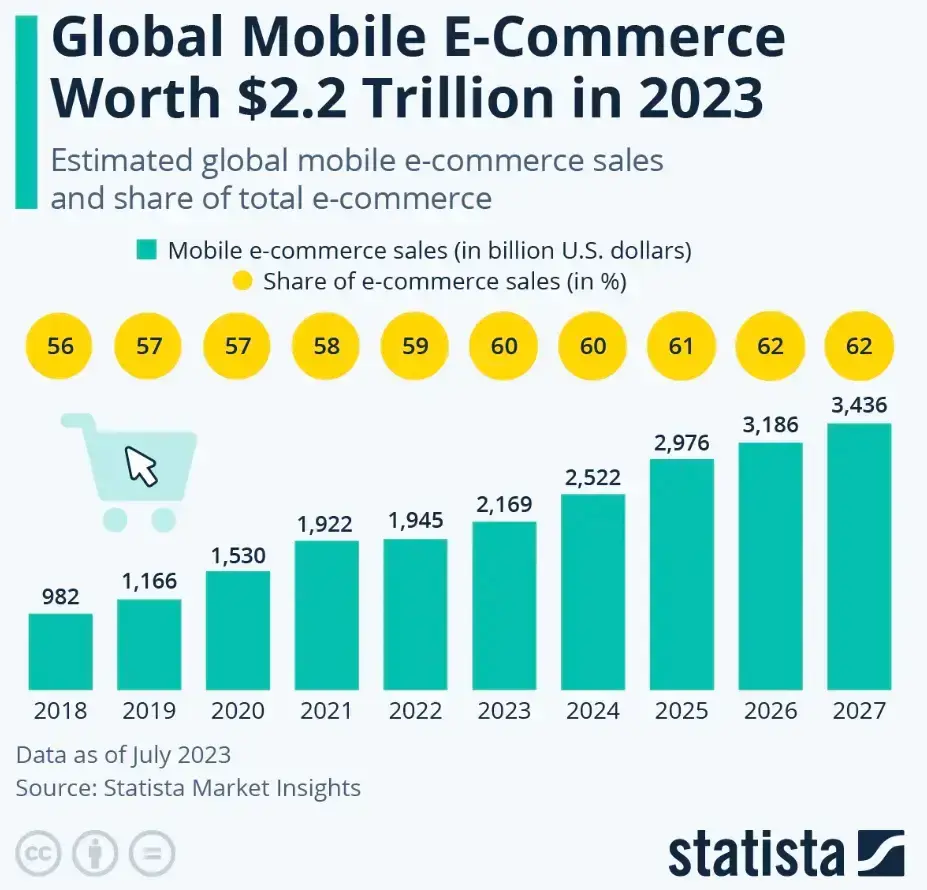Have you ever noticed how shopping online feels different from browsing other websites? Building an e-commerce website isn’t as simple as adding products and a shopping cart to a standard website.
*Updated 8/17/2024
E-commerce websites are a different beast than your run-of-the-mill blog or company website. But what exactly sets them apart?
Below, we’ll explore the unique characteristics that differentiate e-commerce websites from their counterparts.
From their design and functionality to their user experience and security, we’ll uncover how to make these sites so that they specifically facilitate online shopping and enhance customer satisfaction.
Shortcuts:
- Their Purpose and Functionality
- Their Security Requirements
- Their User Experience (UX) Design
- Their Mobile Optimization
- Their SEO Strategy

1. Their Purpose and Functionality
All e-commerce websites, from giants with multiple warehouses in China to small sites owned by independent artists and designers, depend on small business savings accounts and loans.
They are designed and meticulously crafted to guide visitors through a frictionless journey from browsing to buying and ultimately facilitate online sales.
Every element, from eye-catching product images to persuasive descriptions, is geared towards one goal—converting visitors into customers.
In contrast, other types of websites often have broad objectives. A news site aims to inform and engage readers with current events.
A corporate website might focus on building brand awareness and showcasing company achievements. While these sites may indirectly support business goals, they aim to make something other than an immediate sale.
-
Key e-commerce website features
The core features of e-commerce websites are to support and enhance the online shopping experience.
Product listings are at the heart of this, showcasing items with detailed descriptions, high-quality images, and customer reviews.
By providing comprehensive information about each product, e-commerce websites allow users to make informed purchasing decisions.
Additionally, they feature shopping cart functionality, enabling users to add multiple items, review their selections, and make adjustments before checkout.
To support the goal of driving conversions, e-commerce sites also incorporate streamlined checkout processes designed to minimize friction and encourage purchase completion.
These functionalities are in stark contrast to those on other websites.
For instance, a blog primarily focuses on delivering content, with features like comment sections and RSS feeds to engage readers.
Similarly, informational sites might emphasize organized navigation to help users find relevant data quickly.
2. Their Security Requirements

Every time a shopper makes a purchase on an online shopping site, they entrust the site with sensitive data—credit card numbers, home addresses, phone numbers, and sometimes even more personal details.
Ensuring that customer data is stored securely is essential, as any breach can lead to identity theft, fraud, financial losses, and damage to the business’s reputation.
To protect this information, e-commerce websites must implement various security measures, such as:
- Encryption: One of the most basic e-commerce security measures is SSL certificates, which encrypt data transmitted between the user’s browser and the website server. This encryption ensures that any information exchanged, such as credit card numbers or personal addresses, is unreadable to unauthorized parties.
- Data protection compliance: E-commerce sites must also ensure compliance with strict data protection regulations. While specific laws like the GDPR and CCPA apply to all websites, e-commerce sites have to deal with more specific (and demanding) standards, such as PCI-DSS standards.
In practice, this necessitates robust security, acquiring PCI-compliant hosting, installing and maintaining firewalls and vulnerability management systems, passing audits, and ongoing annual or quarterly compliance checks.
Other types of websites certainly need to consider security, but their requirements are often less stringent.
For instance, a blog or portfolio site doesn’t handle financial transactions or store sensitive personal data.
They still need basic security measures to protect against hacking attempts or malware, but they don’t face the same level of risk as e-commerce sites.
3. Their User Experience (UX) Design

UX design is crucial to the success of e-commerce websites. A well-designed online store attracts customers and keeps them engaged, ultimately leading to increased conversions and customer loyalty.
The primary goal of UX design in e-commerce is to create a seamless, intuitive, and enjoyable shopping experience that guides users effortlessly from product discovery to checkout.
Key elements of e-commerce site UX design include:
-
Easy navigation
One critical aspect of e-commerce UX is navigation and search functionality. Users should be able to quickly find the products they're looking for through clear categorization, effective filters, and a robust search feature.
The site's structure should be logical and consistent, allowing customers to browse effortlessly and quickly locate desired items.
-
Effective product pages
Additionally, product pages should provide comprehensive information, high-quality images, and customer reviews to help users make informed purchasing decisions.
Fast load times are also critical, as delays can frustrate users and lead to cart abandonment.
It doesn’t mean other sites don't care about user experience – they absolutely do. However, their definition of a good user experience might look quite different from that of an e-commerce site.
Where an online store might measure success regarding conversion rates and average order value, a blog might look at metrics like time on page or return visitors.
Similarly, a corporate website might prioritize clearly communicating the company's message and making it easy for potential clients to get in touch.
4. Their Mobile Optimization

Today, consumers are more likely to purchase goods and services on their smartphones or tablets rather than PCs. How much more?
In 2023, a Statista study showed that 60% of all e-commerce purchases globally were on a mobile device. Mobile optimization is no longer a nice-to-have feature; it is an absolute necessity for e-commerce websites.
Key elements of a mobile-optimized e-commerce site include:
-
Mobile-friendly checkout process
A mobile-optimized checkout process might mean including options like digital wallet payments, such as Apple Pay or Google Pay, which allow customers to complete purchases with just a fingerprint or face scan.
Auto-fill capabilities for shipping and billing information can also significantly reduce friction in the mobile buying process.
-
Responsive design
Another critical feature is responsive design, which enables e-commerce websites to adapt seamlessly to different screen sizes and orientations.
It involves rearranging product grids, resizing images, and simplifying navigation menus for smaller screens.
-
Mobile apps
Many e-commerce sites also develop dedicated mobile apps, offering features like push notifications for sales or order updates, barcode scanning for easy product lookup, and augmented reality tools for "trying on" products virtually.
While mobile optimization is essential for other websites, the specific features and priorities of e-commerce sites often differ.
A news website could focus on creating a smooth mobile reading experience, with easy-to-use navigation between articles and optimized video playback.
A corporate website might prioritize making contact information and crucial company details easily accessible on mobile devices.
The main difference is that for e-commerce sites, mobile optimization is directly tied to revenue. A clunky mobile experience doesn't just frustrate users; it can lead to abandoned carts and lost sales.
5. Their SEO Strategy

For e-commerce websites, SEO is not just about climbing to the top of search engine results pages – it's about turning those rankings into sales. It requires a unique approach tailored to the world of online shopping.
Key elements of an e-commerce site SEO strategies include:
- SEO product descriptions: Product-focused content is at the heart of e-commerce SEO. It means crafting detailed, keyword-rich product descriptions that inform potential customers and signal relevance to search engines. These descriptions often include specific product features, dimensions, materials, and use cases, all optimized to match common search queries.
- User-generated content (UGC): Product reviews and ratings are gold for online stores. They provide fresh, relevant content that search engines love, and they also build trust with potential customers.
- Schema markup: This structured data helps search engines understand product information, prices, availability, and reviews, potentially leading to rich snippets in search results that can significantly boost click-through rates.
- Local SEO: E-commerce websites also focus on local SEO to attract customers searching for products within a specific geographic area. It includes optimizing product listings with local keywords, claiming and optimizing Google My Business profiles, and ensuring consistent NAP (Name, Address, Phone number) information across all online directories.
While non-e-commerce sites also prioritize SEO, they often target informational keywords and focus on long-form content.
They also focus more on general site structure, content-based link building, and prioritizing engaging content and easy information access.
Ultimately, e-commerce SEO directly targets conversions and sales, while non-e-commerce SEO aims for broader goals like lead generation and brand awareness.
Wrapping Up
From robust security measures protecting sensitive customer data to user-centric designs that streamline the path to purchase, e-commerce sites are designed and built with conversion in mind.
Understanding these differences is crucial for businesses looking to venture into e-commerce.
By recognizing the unique demands and opportunities of e-commerce websites, businesses can make informed decisions about their online strategies.
They can create compelling, secure, and user-friendly platforms that maximize e-commerce potential and drive success.
Try Shift4Shop to launch your eCommerce business today.
Author Bio
Shanice Jones is a techy nerd and copywriter from Chicago. For the last five years, she has helped over twenty startups build B2C and B2B content strategies that have allowed them to scale their businesses and help users around the world.



